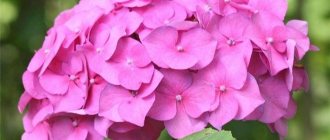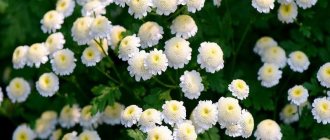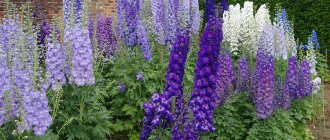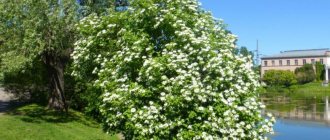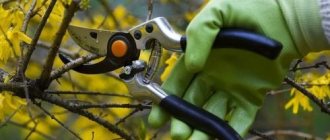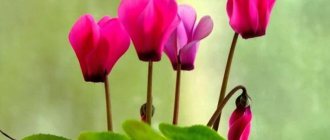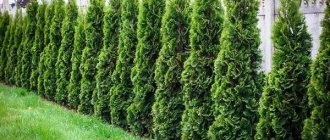When does forsythia bloom?
The flowering period of forsythia, forsythia, occurs at a time when other plants are just waking up from their winter sleep. Although forsythia is known to bloom in the spring, it is not easy to give a specific bloom date. Certain varieties of forsythia bloom at slightly different times. Find out which species blooms earlier, which later, what affects the duration and quality of flowering, and why forsythia does not bloom.
When does forsythia bloom?
Forsythia is the earliest flowering ornamental shrub, signaling the arrival of spring. Flowers appear on the shoots even before the leaves appear. Flowering of F. intermedia (Forsythia x intermedia) - April . Thanks to selection, early flowering varieties were obtained that form buds (in March) or later ( from late April to early May ). Early flowering varieties of F. intermedia include: “Goldrausch”, “Golden Times”, “Spring Glory”, “Primula”, “Vitellina” and “Sunday”. Late-flowering varieties: “Spectabilis” and “Lynwood” finish flowering in May .
Before F. intermedia, F. drooping (Forsythia suspensa) blooms - in the second half of March . A little later, F. ovoid or oval (Forsythia ovata) - the turn of March and April . The earliest variety of F. dark green (Forsythia viridissima) “Citrus Swizzle”, under favorable weather conditions from the beginning of March .
Why doesn't forsythia bloom?
The flowering period of forsythia, depending on the weather conditions prevailing in early spring, may differ from the time specified by the breeders. If the weather is sunny, warm, and precipitation is insignificant, then the shrub blooms earlier, blooms longer and more abundantly. If from the first days of spring it is cool, rainy and there is little sunshine, the flowering period of the shrub is delayed and significantly reduced.
Place of cultivation - affects the timing and duration of flowering. Most varieties require sunny locations, only a few (“Densiflora” or “Golden Times”) tolerate light shade. If you choose a shaded place to grow shrubs, the flowering period will be delayed and shortened, and there will be few flowers.
The flowering period of forsythia can be significantly delayed or even completely inhibited if the bush is pruned at the wrong time . Pruning shoots too late in the fall or too early in the spring results in the loss of a significant number or all of the flower buds. Flower buds develop on the bushes of the plant in the fall. The bush is pruned after flowering. Pruning should be done as soon as the bush fades.
Poorly chosen location
For any plant it is very important that the conditions are favorable. Therefore, before planting, every gardener should think about whether the new resident will be comfortable here? Conditions may change over the years - soil moisture may increase, neighboring trees may provide shade, shade may be provided by buildings that appear nearby
Forsythia is a heat-loving plant, and its growth and flowering can be negatively affected by drafts that were not there before. In addition, over the years the soil becomes depleted. These and other factors can cause poor flowering or its complete absence.
The moisture content in the soil may increase after the creation of an artificial pond, drainage system, or appearance near a garden path. If forsythia is young, it can be replanted, but what to do if the plant is more than one year old? Try point drainage. At a distance of 40 cm from the bush, dig a hole 50 cm deep and fill it with broken bricks, gravel, coarse sand and dry peat.
Forsythia is a sunny garden decoration. Planting, cultivation, care and popular varieties.
Forsythia - early spring flowers
When spring comes, you want to enjoy the beauty of your garden. One of the plants that can definitely make you admire it is forsythia (forsythia). With its bright yellow petals, this shrub is an eye-catcher in parks and alleys.
What rules do you need to follow to grow such beauty yourself? Let's talk about this in the article.
The basis for success (in our case, self-grown forsythia) is proper planting.
Choosing a place
Forsythia is considered an unpretentious plant. But, nevertheless, the choice of landing site must be taken responsibly. This representative of olive trees loves light and does not get along well with the wind. Choose a place protected from shade and wind. Also take into account the size of adult bushes (width - 2 m, height - 3 m).
Choosing a time to land
Forsythia seedlings are planted (and transplanted) in the fall, before frost, or in the spring.
If you are interested in knowing how to properly plant and care for lawn grass, read about it here.
You can also read about the favorite of gardeners - viburnum, its planting and care.
Soil selection
This plant is also not picky about soil. The desired condition is dry soil of neutral acidity. If your soil is highly acidic, neutralize it by liming or mixing it with wood ash.
Landing Features
Prepare holes about 50 cm in length and width, depth - about 70 cm. The distance between them is 1.5-2 m. Next, fill in this order:
- 15-20 centimeter drainage layer (use crushed stone or broken brick).
- A layer of sand about 10 cm thick.
- Mixed sand, humus and leaf soil in a ratio of 2:1:1.
After planting, it is necessary to compact the soil around the seedlings. Water generously.
This plant does not require any complex special care.
It is recommended to feed it only 3 times per season:
- In early spring, the bushes are sprinkled with a thick layer of humus, which simultaneously serves as mulching and fertilizing.
- Before the flowering period in spring, it is recommended to feed it with a full range of mineral fertilizers (about 60 g per bush).
- After flowering, the plants are fertilized with phosphorus-potassium fertilizer (about 100 g per bush).
Proper care of forsythia will ensure its bright and beautiful flowering
Regular care consists of watering and loosening the soil. The plant does not need frequent watering.
Freesia needs to be watered 1-2 times a month in the summer, pouring about 10 liters of water into one bush if the summer is dry. If the frequency of precipitation is normal, the plant does not require additional watering at all.
Afterwards you need to loosen the soil around (this needs to be done deep enough, be guided by the length of the shovel bayonet). Mulch the tree trunk area with dry soil or compost.
Pruning this plant is considered by many to be the most difficult part of care. This is done in several cases:
- If you want to rejuvenate your forsythia. In this case, trim all branches by 4-6 cm to stimulate the growth of new shoots. It is recommended to carry out once every 3-4 years.
- To regulate the height and shape of your bush. We advise you not to get too carried away and do it as carefully as possible.
- After flowering, creating conditions for the growth of young shoots. In this case, the branches that have bloomed need to be cut in half, and those that have already dried out must be cut so that 4-6 cm remain from the ground level (side shoots will come from them).
- In case of sanitary pruning. Used for young bushes. It is necessary to get rid of all damaged (broken, frozen or shriveled) shoots.
Preparing for winter
After the forsythia has withered, it is necessary to take care of its flowering next year. The tree trunk area is covered with leaves, branches, and spruce branches to protect the plant from winter frosts.
For more information about planting and caring for forsythia, watch the video:
Failure to follow pruning rules is the main mistake of novice gardeners
One of the main factors in caring for forsythia is pruning the plant. Even beginners know the importance of this process not only for rejuvenation, but also for the health of the bush. Often, due to improper pruning, flowering stops, and this happens because on a forsythia bush the flower buds are located on biennial shoots, and therefore, if you shorten the shoot incorrectly, you can remove the unopened flower itself.
In order for pruning to be successful, it is better to carry it out gradually, without removing all the old shoots at once.
Important! For beginners, it is recommended to prune after flowering, and not before it.
Trimming
The pruning process can be roughly divided into three stages:
- removing old branches;
- bush thinning;
- shortening branches that have bloomed (by a third).
Pest and disease control
Forsythia is a plant that is resistant to pests, but it has no immunity to various diseases.
This disease is characterized by the sudden death of individual branches during the flowering period. To get rid of it, medicinal (eradicating) fungicides are used. Disease prevention is also carried out by treating plants with protective fungicides.
Characteristic signs are yellowing from the edges, gradually spreading to the middle of the leaf, affecting the plant, the veins turn black, and the plants are depressed. A section of petioles and stems shows darkening of the blood vessels.
If symptoms of bacteriosis are observed, the best solution would be to remove the affected plant along with the roots, because bacteriosis is an infectious disease that can easily spread to nearby bushes.
This type of plant is rarely affected by nematodes, but does occur occasionally. Nematodes are thread-like roundworms, up to 1 mm in length, that parasitize plant leaves. Leaves affected by the nematode become covered with irregularly shaped spots, shrink and wither. After some time, the sheet becomes so thin that it is visible in the light. Soon the entire plant dies.
To avoid the appearance of nematodes, you need to use only treated garden soil and healthy cuttings.
A small insect characterized by great fertility. Aphids are clearly visible on the leaves - 1.5 mm long insects of a grayish-white color. When a plant is infested with aphids, the leaves turn yellow and dry out.
To combat aphids, there are a lot of chemical and folk remedies, some of which are potassium chloride and a solution of laundry soap.
Read about the features of planting and growing annual dahlias in the article.
Types and varieties
There are 7 types of forsythia in total. Each has its own distinctive characteristics and is divided into varieties.
European forsythia (Forsythia europaea) is the most common variety in our area. The height of the bush does not exceed 2 m. It has oblong leaves up to about 7 cm long. Blooms with golden yellow bell-shaped flowers. It is durable and can live up to 70 years.
Forsythia ovata is a species that blooms earlier than all others. This is a spreading shrub up to 2 m high, has oval leaves, pointed upward, and bright yellow flowers. In autumn it pleases the eye with colorful leaves. Frost-resistant. Known varieties:
Hanging forsythia (Forsythia suspensa) - common in East Asia. It has long branches going down to the ground. The flowers are quite large and orange-yellow in color. Several varieties are known:
- Motley;
- Forsythia Fortune;
- Purple-stemmed;
- Forcisia is deceptive.
Forsythia Giraldiana - similar in appearance to European forsythia, but differs in a lighter shade of flowers. The leaves are dark green, large, up to 10 cm long. It also reaches a height of up to 2 m and has straight stems.
Dark green forsythia (Forsythia viridissima ) is a shrub with a height of up to 3 m. It received its name due to its dark large (up to 15 cm in length) leaves directed upward. It has light yellow flowers collected in bunches. Drought resistant.
Snow or white forsythia (Forsythia abeliophyllum) . The plant got its name due to the white color of the flowers. The height of the bush is about 2 meters, the leaves are small, up to 8 cm, in summer their lower side becomes slightly purple.
Intermedia forsythia (Forsythiax intermedia) is a hybrid of drooping and dark green forsythia. It begins to bloom only from 4 years of age. The leaves are dark green in color, the flowers are bright yellow. Resistant to frost and drought. Grows up to 3 meters. Known varieties:
See photos of forsythia species in the gallery:
Forsythia flower fountains: planting, feeding, pruning
After a long winter, any gardener wants to enjoy the bright colors and spring mood. Golden forsythia bushes that bloom in April can give such joy. Forsythia is a tree-like shrub of the Olive family, valued by gardeners and landscape designers around the world for its unique decorative properties.
The period of active budding begins in the first ten days of March or early April. It is during this period that lush, medium-sized yellow flowers bloom on the branches of the bush. There are representatives with white, pink and purple inflorescences. The buds are located so close that from a distance they resemble a bright crown. The formation and growth of foliage occurs in the second phase of the vegetative period, after the flowers wither.
From hanging to European: what to choose for planting?
Forsythia, also known as forsythia, is considered one of the oldest shrubs. The current distribution area extends from Albania to pan-Asian states. If you want to grow forsythia in the garden, many manuals have been written about planting and caring for it in the open ground. Acquaintance should begin with studying the species and varieties. In Russia, the most popular are drooping, ovoid, European, and hybrid.
- Forsythia drooping is a shrub with a spreading crown that grows up to 3 m in height. The branches have a drooping, arched shape. The flowers are relatively small, about 2.5 cm in diameter, collected in inflorescences on the branches. Despite its high drought resistance, it begins to wilt in the heat. To prevent this, the plant needs to be watered and mulched abundantly. In landscape design, the most popular varieties of this species are variegated forsythia, golden fortune, and deceptive. These specimens are often used to decorate home walls. All representatives of the hanging group are not cut, since their beauty lies precisely in the curved shoots. If desired, you can slightly shorten the young growth.
All of the listed varieties of flowering forsythia are adapted to the conditions of the Russian sharply continental climate. The Giralda species, reaching 2 m, prefers to spend the winter with shelter in regions with harsh winters. The greenest forsythia with vertical branches freezes slightly in the northern regions and does not bloom every year.
Application in landscape design
Hanging specimens are ideal for decorating roofs, gazebos, fences, and outbuildings. The ideal combination is Alba with pale pink flowers and Spring Glory, which changes the color of the leaf blades to pale purple in the fall. Among the new cultivators, they choose Vic End and Melissa, which blooms in early spring. If you regularly trim the bushes, you can use the shoots to create a picturesque hedge that changes color from spring to autumn.
Paired with golden bushes, blooming rhododendrons, weigels, spireas, and barberries look fantastic. If you plant a tree peony nearby, it will lead the procession after the forsythia blooms.
How to choose the right seedling in a store
The very first and, perhaps, fundamental question concerns the purchase of forsythia seedlings. How to make the right choice so as not to regret it in the future?
We do not recommend buying plants from people without the necessary documents confirming their trading activities and professionalism in the field of plant trading. Simply put, it’s better not to take it “from hand.” Order seedlings from organizations, shopping centers, in a word, from those who specialize in landscape design and have established relationships with trusted nurseries and plant suppliers. It is better to entrust the choice to an experienced dendrologist. Another advantage to this is that, being next to him, you will receive basic but necessary information about your future plant.
If you decide to make a choice yourself, then definitely go to the trade fair. Since choosing a forsythia seedling, like any other plant, is not easy, it is better to have a certain reference book with you. This is how you will choose, ask leading questions, and generally navigate this type of product.
You have every right to ask for a quality certificate regarding the forzia you choose
The main points to pay attention to are the supplier country and the climatic zone of growth. What looks great when planted doesn't necessarily stay that way until the very end.
Pay attention to the age of the seedlings. The older the plant is and the more the conditions during future planting differ from the previous ones, the more difficult it will be for the shrub to adapt
When choosing a seedling, examine not only the one you like, but also the others. If there is at least one patient among them, leave there with nothing. An infected plant will be an extra troublesome task for you, since it will not only require special care, but will also infect nearby plants. Buy only seedlings with thick and strong branches with many buds. Do not purchase plants with broken branches or damaged shoots.
Did you know? The ornamental shrub received its name in honor of the botanist from Scotland William Forsyth, part-time head gardener of Kensington Palace and one of the founders of the Royal Horticultural Society. He was the first to bring the forsythia bush from the Celestial Empire to Europe.
Growing according to all the rules: site selection taking into account privileges
The easiest way is to plant young seedlings purchased in specialized stores at the dacha. They are planted in well-ventilated, illuminated places at a sufficient distance from other plants (at least 1.5 m). Lack of light and space can be the reasons why the bush does not bloom for a long time. Plants successfully tolerate light shading, but flowering in this case is not as abundant as we would like.
The recommended distance between seedlings is 1.5-2 m, taking into account the height of the purchased specimen in adulthood.
Blooming forsythia is highly unpretentious to the soil composition of the soil. The main and only taboo when planting is high groundwater, as well as swampy areas. The root system of forsythia is unstable to excess soil moisture, so gardeners carefully monitor stagnation of water in the hole.
When and how to plant forsythia?
The best time for planting and replanting is autumn (before the first frost). Crocuses will be excellent companions. The purple petals of primroses in combination with the golden inflorescences of forsythia will make an indelible impression on the guests of the site.
Landing instructions:
- A pit is prepared with a size of 50*50 or 60*60 cm. Drainage from crushed stone or crushed brick is poured into the bottom with a layer of 15-20 cm, then a bucket of sand is added.
Watering and fertilizing
With balanced rainfall, watering forsythia is not required. If hot weather lasts for a long time, then once a month you need to pour 10-12 liters of water under the bush.
In total, no more than 3 feedings are carried out during the season:
- first - in the spring, after the snow melts, rotted manure or 70 g/m² of mineral fertilizer is laid out under the bush;
- second - after flowering, add 100-120 g/m² Kemira-station wagon;
- third - a month before preparing for wintering, potassium-phosphorus preparations are introduced.
Growing video.
Pruning, whitewashing, preparing for winter
Young seedlings are not cut for several years - the branches are allowed to grow. Before flowering, only frozen shoots are cut off. Subsequently, the branches of most varieties are cut by 1/3. Spring sanitary pruning, during which dry and frozen shoots are removed, allows the plant to look more decorative at the height of flowering. For general rejuvenation, old branches are cut to the base, leaving a distance of 3 cm from the ground.
Sanitary preventive treatment, carried out in spring or autumn, protects the plant from parasites and a number of fungal diseases. A soap solution based on laundry or bath soap or an infusion of wood ash can be used as a reagent.
Whitewashing the trunks of adult plants is carried out 1-2 times a year (October-March) to protect the bushes from parasites, frostbite, and overheating in the spring.
Often in bright sunlight in early March, many ornamental crops emerge from hibernation ahead of schedule. Active movement of tree sap begins in heated trunks and branches. Early vegetation in 78% of cases causes frostbite of buds and buds. Slaked lime, garden varnish, and an elastic bandage can be used as a protective material.
During the period of active leaf fall, the ground in the hole is mulched with fallen leaves. Thin branches are pressed to the ground or attached to the main trunk using plastic clamps. The plant is tied with covering material and covered with spruce branches until the next season.
Neglecting the rules of wintering plants
Very often, gardeners neglect the quality of the shelter that is built for the bush for the winter, and the consequence of this is that only the lower branches bloom in the fall or flowering in general becomes much worse. The opinion that forsythia does not require special concern about the “roof” is a little erroneous, because the branches can not only freeze, but if there is insufficient shelter, they can be damaged by birds remaining for the winter.
Usually, by winter, the tree trunk circle is covered and the branches are covered. You might think: how can you cover a fairly voluminous bush? It’s very simple: the branches are carefully tied together with a rope.
Did you know? As a shelter, it is better to use exclusively woven material that allows air to pass through, in order to prevent the buds from awakening ahead of time.
If it so happens that you had to use non-woven material, then you need to remove such cover gradually. You can use snow for additional cover.
As you can see, the health of the bush and its appearance largely depends on the care that the plant receives, and we hope that this article will help you take care of your forsythia correctly.
Why doesn't forsythia bloom?
There are several reasons that inhibit the formation of buds. These include:
- saline heavy soil (secondary symptom - many deformed, underdeveloped shoots and leaves, slow growth of the bush);
- stagnation of water in the hole can be easily determined by the state of the plant crown (foliage falling for no reason, a large number of yellowed leaf blades, rotting of the root node of the tillering);
- improper sanitary pruning (many buds were cut off);
- lack of nutrients in the soil;
- freezing of the buds in winter;
- presence of pests.
Having neutralized the above problems, flower growers manage to activate the formation of buds in 83% of cases. In cases where the plant continues to develop slowly and does not produce flowers, the owner decides on additional feeding with potash fertilizers.
Despite rapid advances in modern breeding, scientists have still not been able to develop a specific hybrid. There are only about 8 species in the Royal Botanical Directory, where each forsythia has a photo and description.
0
Back
Planting lilies in open ground in spring
MORE
Too dry
A shrub that grows in any soil, due to its shallow root system it is sensitive to a lack of water in the soil. The situation occurs more often on light sandy soils. The plant reacts to drought by withering leaves and young shoots. In dry summers, the plant loses its ability to set buds, which is a consequence of damage to young shoots.
On sandy soils, shrubs require mulching with garden bark or black non-woven material, which limits the evaporation of water from the soil. In hot years, young bushes require watering, especially on light soils.
